Villanova 4-out 1-in motion
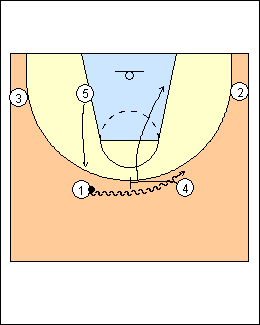 | 1 Jay Wright Hofstra, Villanova 1, 2, and 3 occupy three of the four perimeter spots, slots and wings. The slots are 2-3 feet off the lane, the wings are mid-post extended with a good post player, block extended with a good slot player. Spacing is about 18 feet. Guards on the same side can screen for each other, guards don't screen for the bigs. After passing, guards screen, basket cut, or use a screen. 4 and 5 fill two of the four mid-post and slot positions, always high-low opposite each other. Post up in prime time, straddling the first marker above the block. Posts screen for the guards (always screen for the slot then second cut), not for each other. Ballscreens (only at the top) are always pick and roll and replace. Hofstra - if 1 penetrates, 4 pops (second cut) and 5 stays weakside; if 1 drags the dribble to the other slot, 4 rolls and 5 replaces; if X5 helps on 4 rolling, pass to 5 popping, 4 seals. |
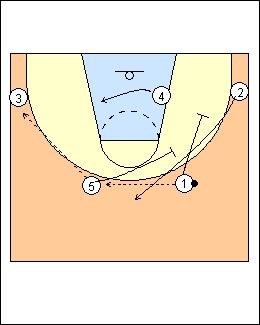 | On ball reversal, 1 and 5 stagger screen for 2. Hofstra - scoring opportunities come from post-ups, high ballscreens, and screener-cutter situations, but also from side ballscreens. 4 will ballscreen for 3 if there is no post-up (or pass to 2). Perimeter players leave a spot, fill a spot. Dribble to drive to the basket or make an easy pass - dribble somebody through. Catch to shoot, eyes on the rim, you will also see into the post and ball reversal. The low post ducks in on a pass to the high post, the high post rips to the weakside block on a pass into the low post, who goes baseline to score and middle to explore (post and rip). |
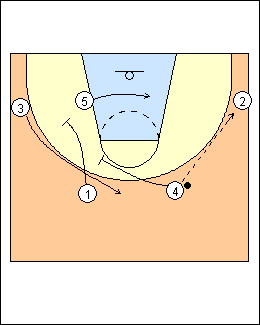 | 3 Here is another example of a staggered screen. |
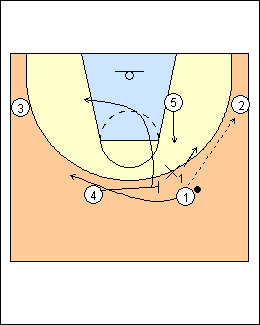 | 4 Take lanes - take the open lane that the defence gives you. Here if X1 jumps to the ball on the pass to 2, don't fight it, use the flarescreen instead of trying to basket cut. Read opposite - the cutter reads opposite his defender (e.g., out cuts if his man goes under a screen), the screener reads opposite the cutter, and is the second cutter. Here if 1 curled, 4 would pop. |
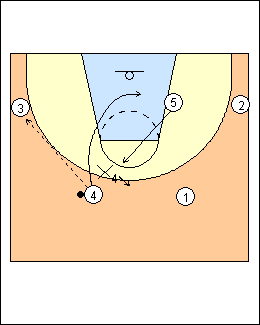 | 5 Here X4 jumps to the side on the pass to 3, so 4 basket cuts instead of fighting through to screen away for 1. |
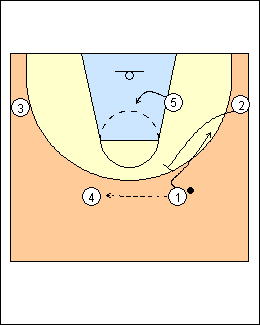 | 6 Communication is needed. Here 2 calls 1's name to let him know he is the cutter (guards can screen for each other). 2 can basket cut or pop. |
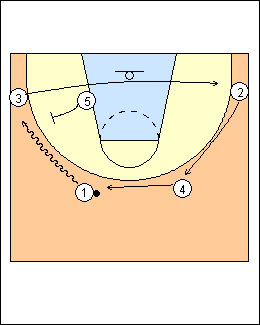 | 7 Special plays a) Wing 3 is a shooter. 1 dribbles to the corner if he wants space to operate, or to the foul-line extended if 5 can pop and shoot. 5 ballscreens. Hofstra - 1 passes to 3 who looks to hit 5 inside then gets a ballscreen. 1 and 4 stagger screen for 2, 1 is the first screener, 4 rolls to the basket. |
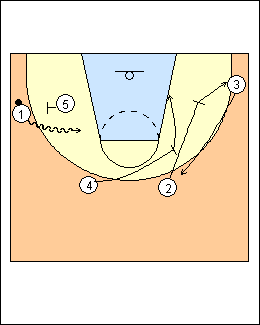 | 8 2 and 4 stagger screen for 3, 4 rolls to the basket, 2 goes to the corner. |
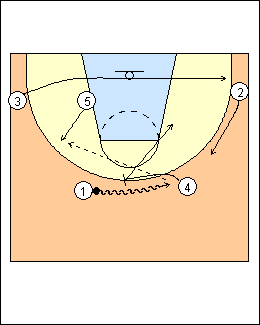 | 9 b) Pop Isolation for 5. |
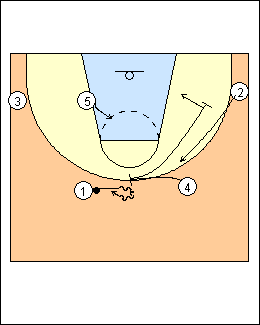 | 10 c) Punch 1 dribbles at the ballscreen then spin dribbles, 5 seals his defender with a leg whip (steps between the defender's legs with his right foot, reverse pivots on it). 1 looks to pass directly to 5 inside, or to 3 for a baseline pass to 5. When 1 spins, 4 screens away for 2 then rolls to the basket. |
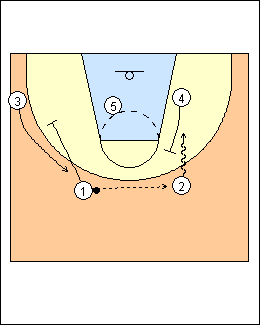 | 11 If 1 passes to 2 in the slot, 2 passes inside to 5 or otherwise gets a ballscreen from 4. 1 screens away for 3. |
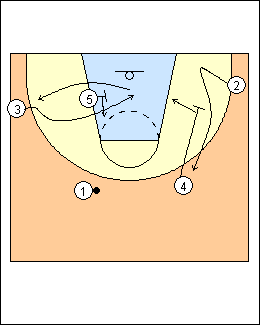 | 12 d) Pin Get the ball to 5 in the middle of the lane. 3 face cuts to the rim and clears back out using a pin screen from 5, who then steps to the ball. 1 looks to hit 5 inside, 3 for a baseline pass to 5 (reverse pivoting to seal), or 2 for a high-low pass. 4 screens away for 2 when he sees 1 not pass to 3 or 5. 2 v-cuts away when he sees 4 coming. If 1 passes to 2 and 2 does not pass to 5, 4 ballscreens. If they know X5 will help high on 3, 5 will set the pin screen halfway between the arc and the lane for room to slip (pin-slip). Option - initiate the action with a ballscreen by 4, 1 makes a crossover dribble at the screen to reject it. Mark Few - 5 backscreens then downscreens for 3. |
This page was made with Basketball playbook from Jes-Soft